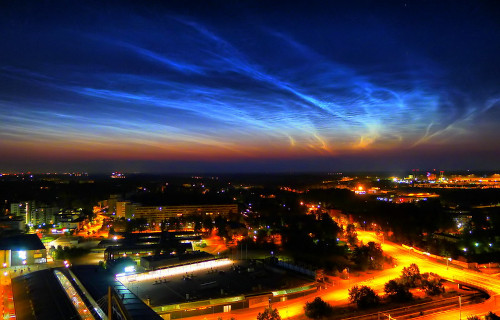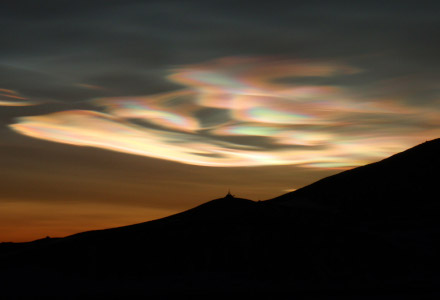
CCL: https://bit.ly/3B8s22r
For thousands of years, mankind has gazed skyward with a mixture of awe and wonder at the beauty and variety of clouds such as these 5 Rare Mind-blowing Cloud Types. Yet, only in the last few centuries have we begun to understand the complex interaction of forces which forms and shapes clouds. It was not until 1802 that Luke Howard started classifying clouds into groups.
Even today, with all our science, some types of clouds have only now begun to yield forth their secrets. Presented here you will find a collection of 5 Rare Mind-blowing Cloud Types, and therefore some of the least (or most recently) understood, of all known cloud formations. They also rank among the most beautiful.
CCL: https://tinyurl.com/2p72bfpk
1. Undulatus Asperatus Clouds
As one of our 5 Rare Mind-blowing Cloud Types, the incredible Undulatus Asperatus Clouds is one the newest recognized formations. It is only in recent years that scientists have begun to study and understand the forces that shape these incredible clouds. The fact that this particular cloud pattern rarely lasts more than a few minutes has made it rather difficult for meteorologists to study them.
While they often appear dark and gloomy, and often near ongoing storms, these clouds almost always dissipate without a storm forming.
Undulatus Asperatus clouds rarely occur so scientists have had only limited opportunities to study them. They appear to develop when undulations within the atmosphere cause the air to move up and down. Also, they typically only occur in low-lying clouds. While the altitude at which they occur naturally varies, they rarely form above 6,562 ft (2,000 m).
As a result of their proximity to the ground, the up and down flow of the winds bounces off the ground and back to the base of the clouds, creating a remarkable wavy pattern.
2. Nacreous Clouds
Another of our 5 Rare Mind-Blowing Cloud Types, the astonishingly beautiful Nacreous Clouds remains an extremely rare and beautiful sight to behold. Yet, as sometimes occurs, this incredible beauty conceals a dark secret. Unlike most other clouds, these actually form high up in the stratosphere, at altitudes of at least 70,000 ft (21,336 m) or above.
Also, because of their unique chemical composition, Nacreous clouds, while beautiful to the eye, actually contribute to the destruction of the ozone layer above the Arctic and Antarctic regions.
Nacreous Clouds however typically only occur in the higher latitudes of both hemispheres. Rarely do they appear outside Alaska, Iceland, Scandinavia, Northern Canada and sometimes as far south as England.
Other clouds do not typically form at the altitude of Nacreous Clouds because it stays far too dry for ice crystals or supercooled droplets to form. These beautiful yet destructive clouds form there because they also contain nitric acid. Sunlight then strikes the clouds, with the nitric acid suspended within them, which releases chlorine gas via a photochemical reaction.
3. Lenticular Clouds
The visually stunning and mesmerizing Lenticular Clouds are the third of our 5 Rare Mind-blowing Cloud Types. Like all of the formations on our list, they also only form under specific conditions. They only occur over or near mountains.
Due to their rather distinctive lens-shaped structure, they have often been mistaken for UFOs. Part of this confusion stems from the fact that, unlike almost all other types of clouds, this formation remains rather stationary.
Lenticular Clouds typically occur on the downwind side of either a single mountain or a mountain range thereby creating an incredible sight. When air both stable and moist flows over a mountain it creates a series of oscillating waves.
Yet the distinctive disk shape only forms when the temperature at the crest of the wave equals that of the dew point temperature. In some instances, the air will fall down the trough of the wave, and actually, form a stack of such incredible clouds!
4. Kelvin Helmholtz Clouds
The fourth of our 5 Rare Mind-blowing Cloud Types is perhaps the most difficult for scientists or cloud watchers to study. That’s because these astonishing formations rarely last for more than few minutes. Sometimes called billow clouds, these unique clouds resemble breaking ocean waves.
They also only occur on the upper portion of their associated clouds. What appears to be a series of rolling eddies also generally tends to appear at regularly spaced intervals.
Lord Kelvin and Hermann von Helmholtz were the first men to officially study and document these clouds. Kelvin Helmholtz Clouds occur when clouds remain suspended between two different layers of air, and each layer moves at a different speed. Also, the upper layer of air must be the faster of the two.
Since the clouds often appear during a period of temperature inversion, they indicate atmospheric instability. While they can appear anywhere, they most commonly develop in the Southern Hemisphere.
CCL: https://bit.ly/3B8s22r
5. Noctilucent Clouds
The magnificent Noctilucent Clouds are our last in 5 Rare Mind-blowing Cloud Types. To many people, they also represent the most beautiful of all the rarely seen clouds. They display ethereal colors and beauty. We only see them because of the presence of ice crystals too small to cause iridescence.
They also form at the smallest size of any known atmospheric ice crystal. In recent years, they have begun to form at slightly lower altitudes than ever before. Changes in our atmosphere appear to be the primary reason.
Noctilucent Clouds form in the mesopause, the highest part of our atmosphere or between 50-53 mi (80-85 km)! They require a highly specific combination of factors to form: extremely low temperatures, water vapor, and nuclei for the particles. At those altitudes, these particles are either volcanic ash or meteor dust.
These stunning clouds typically appear at their best during deep twilight. While many colors may be seen, blue is the most common. Red and gold also occur as a result of illumination by low-angled sunlight.
Have you seen any of these cloud formations? If yes, where? Which one is your favorite?
Check out our articles on Amazing Conservation Photography, 6 Mysterious Natural Phenomena

